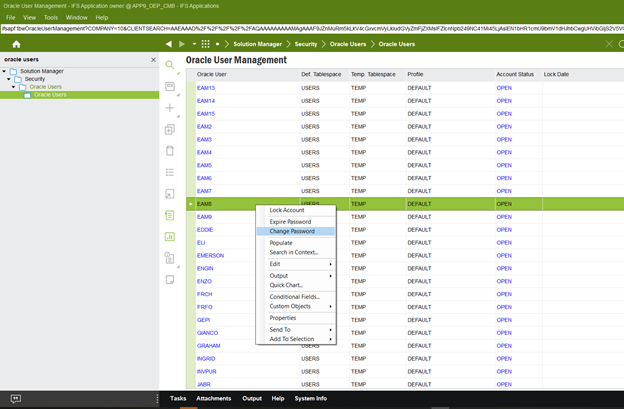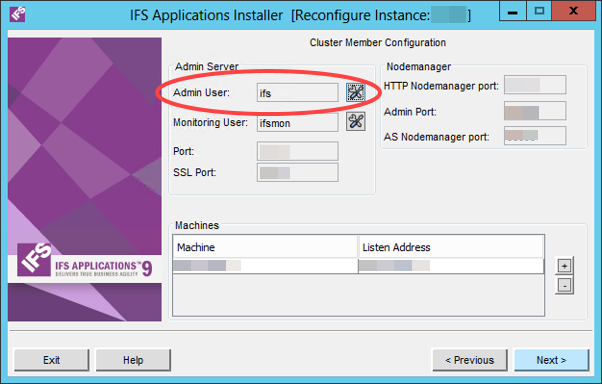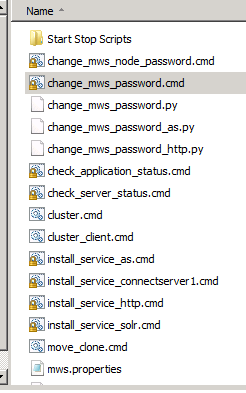Hi All,
How to reset F1 user "IFS" Password. Share procedure, if screen shot highly appreciated.
Please advise.
Reagrds,
Vivek NR.
Hi All,
How to reset F1 user "IFS" Password. Share procedure, if screen shot highly appreciated.
Please advise.
Reagrds,
Vivek NR.
Hi
Go to Oracle User Management screen
Search for the user / Find the user
RMB → Change Password

Then you will be asked to enter the new password.
Hope this will help you!
hi
I hope my previous explanation won’t help you since I misunderstood your question. You want to change the password of the user ‘IFS’.
I hope you can achieve this by executing the “change_mws_password.cmd” script which is located inside the “<IFS_HOME>/instance/<instance_name>/bin” folder
Hi
YES, IFS user’s password reset procedure required.. :-(
Regards,
Vivek NR.
HI
If we forget IFS Password, then how to reset the password.?
Regards,
Vivek NR.
HI
If we forget IFS Password, then how to reset the password.?
Regards,
Vivek NR.
HI
If you forget the password, ask another user who has administrator access to change your password(Previous password not needed) in Oracle User Management window as
Thank you
HI
If you forget the password, ask another user who has administrator access to change your password(Previous password not needed) in Oracle User Management window as
Thank you
Hi
My previous explanation referring to the Oracle User Management screen is incorrect since
I believe you’d have to do it through the database
ALTER USER user_name IDENTIFIED BY new_password;
Hi
When I create a new test instance I would tend to change this password in the IFS Applications Installer, with the reconfigure option. Although I expect

I believe you’d have to do it through the database
ALTER USER user_name IDENTIFIED BY new_password;
HI
User ‘ifs’ is not an oracle user; hence we can’t change the password using the approach that you have mentioned.
Hi
By using the "change_mws_password.cmd" script, you can change the password of the user 'ifs'.
However, you have to enter the current password. Therefore, you can't use this script when you do not remember the password.
As far as I know, in such a case, it is recommended to recreate a new IFS HOME instance using the build home.
Note that, user 'ifs' is not an F1 user and it is the web logic admin user.
Hope this will help you.
Best Regards,
Binura.
Hi, You can reset the IFS Middleware user password using the change_mws_password.cmd script under C:\ifs\<instance_name>\instance\<instance_name>\bin.

This script requires you to input your current IFS user password. If you aren’t sure, it is recommended to Delete and Create New the IFS instance using installer.cmd.
Good luck!
Here's how to recover the WebLogic user passwords in Apps 9. I haven't tested this in Apps 10.
First, get the middleware configuration file:%IFS_HOME%\instance\%INSTANCE%\%INSTANCE%_configuration.xml
If you need the password for the ifs user, get the value in this key:<ifs.fndmws.admin.password.encrypted>
If you need the password for the ifsmon user, get the value in this key:<ifs.fndmws.monitoring.password.encrypted>
At a minimum, you'll need four files from the IFS application. These may have been supplied with your initial upgrade or implementation delivery:.\build\framework\classes\installer_plugins\fndweb\ifs\fnd\service\IfsEncryption.class
.\build\framework\classes\installer_plugins\fndweb\ifs\fnd\service\IfsEncryption$EncryptionException.class
.\build\framework\classes\installer_plugins\fndweb\ifs\fnd\util\Base64.class
.\build\framework\classes\installer_plugins\fndweb\ifs\fnd\util\EndOfStreamException.class
The easiest way to get this working is to work straight out of that FNDWEB folder. (That takes care of dependencies without having to recreate their folder structure.) Assuming your delivery is extracted to the same server as your application, you can harness the Java executable you already have.
You'll need to create two new files.
1. Create new file: .\build\framework\classes\installer_plugins\fndweb\MyDecrypt.java
import ifs.fnd.service.IfsEncryption;
public class MyDecrypt {
public static void main(String[] args)
throws Exception
{
System.out.println(IfsEncryption.decrypt(args[0]));
}
}
2. Create new file: .\build\framework\classes\installer_plugins\fndweb\MyDecrypt.bat
@echo off
setlocal enabledelayedexpansion
set ENCRYPTED=CgQItFLEmLiSxbfO08pKOKEUoJRpniqiGW4nKdevcRZQfBc=
set CLASSPATH=.
set "IFS_HOME=D:\IFS_DEV1"
set "JAVA_HOME=%IFS_HOME%\mw_home\java"
set "PATH=%JAVA_HOME%\bin\;%PATH%"
javac MyDecrypt.java
java MyDecrypt %ENCRYPTED%
pause
You'll need to edit that file, changing ENCRYPTED and IFS_HOME as appropriate.
Run MyDecrypt.bat, and the password will echo to the terminal.
I don’t understand why changing IFSAPP password should be this complicated. We have simply been using the normal way of changing any user’s password through the application, which is using the Change password feature when logging into the system. Is this because you have forgotten the current IFSAPP password?
You are right, resetting Oracle user passwords like IFSAPP is straightforward and can be done through the application or running a SQL Alter User command.
Here's how to recover the WebLogic user passwords in Apps 9. I haven't tested this in Apps 10.
First, get the middleware configuration file:%IFS_HOME%\instance\%INSTANCE%\%INSTANCE%_configuration.xml
If you need the password for the ifs user, get the value in this key:<ifs.fndmws.admin.password.encrypted>
If you need the password for the ifsmon user, get the value in this key:<ifs.fndmws.monitoring.password.encrypted>
At a minimum, you'll need four files from the IFS application. These may have been supplied with your initial upgrade or implementation delivery:.\build\framework\classes\installer_plugins\fndweb\ifs\fnd\service\IfsEncryption.class .\build\framework\classes\installer_plugins\fndweb\ifs\fnd\service\IfsEncryption$EncryptionException.class .\build\framework\classes\installer_plugins\fndweb\ifs\fnd\util\Base64.class .\build\framework\classes\installer_plugins\fndweb\ifs\fnd\util\EndOfStreamException.class
The easiest way to get this working is to work straight out of that FNDWEB folder. (That takes care of dependencies without having to recreate their folder structure.) Assuming your delivery is extracted to the same server as your application, you can harness the Java executable you already have.
You'll need to create two new files.
1. Create new file: .\build\framework\classes\installer_plugins\fndweb\MyDecrypt.java
import ifs.fnd.service.IfsEncryption; public class MyDecrypt { public static void main(String[] args) throws Exception { System.out.println(IfsEncryption.decrypt(args[0])); } }
2. Create new file: .\build\framework\classes\installer_plugins\fndweb\MyDecrypt.bat
@echo off setlocal enabledelayedexpansion set ENCRYPTED=CgQItFLEmLiSxbfO08pKOKEUoJRpniqiGW4nKdevcRZQfBc= set CLASSPATH=. set "IFS_HOME=D:\IFS_DEV1" set "JAVA_HOME=%IFS_HOME%\mw_home\java" set "PATH=%JAVA_HOME%\bin\;%PATH%" javac MyDecrypt.java java MyDecrypt %ENCRYPTED% pause
You'll need to edit that file, changing ENCRYPTED and IFS_HOME as appropriate.
Run MyDecrypt.bat, and the password will echo to the terminal.
Hi
How to do the same in Apps 10?
in Apps 10 there is no fndweb folder in \build\framework\classes\installer_plugins\
Please tell me how to do the same process in Apps 10.
Thank You.
You can find this classes in fndweb_installer.jar, but You should use file from APP9 version.
Just unzip jar.
I tested this solution and it works.
Enter your E-mail address. We'll send you an e-mail with instructions to reset your password.